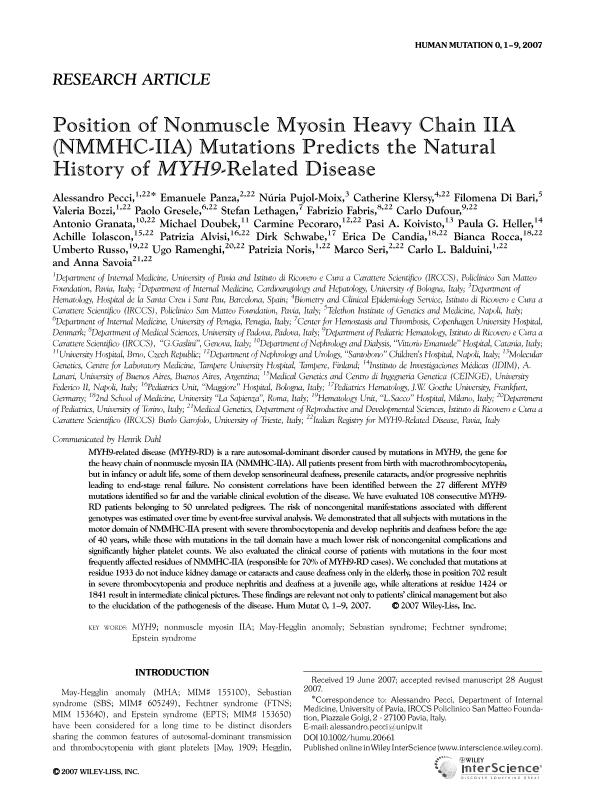Artículo
Position of nonmuscle myosin heavy chain IIA (NMMHC-IIA) mutations predicts the natural history ofMYH9-related disease
Pecci, Alessandro; Panza, Emanuele; Pujol Moix, Núria; Klersy, Catherine; Di Bari, Filomena; Bozzi, Valeria; Gresele, Paolo; Lethagen, Stefan; Fabris, Fabrizio; Dufour, Carlo; Granata, Antonio; Doubek, Michael; Pecoraro, Carmine; Koivisto, Pasi A.; Heller, Paula Graciela ; Iolascon, Achille; Alvisi, Patrizia; Schwabe, Dirk; De Candia, Erica; Rocca, Bianca; Russo, Umberto; Ramenghi, Ugo; Noris, Patrizia; Seri, Marco; Balduini, Carlo L.; Savoia, Anna
; Iolascon, Achille; Alvisi, Patrizia; Schwabe, Dirk; De Candia, Erica; Rocca, Bianca; Russo, Umberto; Ramenghi, Ugo; Noris, Patrizia; Seri, Marco; Balduini, Carlo L.; Savoia, Anna
 ; Iolascon, Achille; Alvisi, Patrizia; Schwabe, Dirk; De Candia, Erica; Rocca, Bianca; Russo, Umberto; Ramenghi, Ugo; Noris, Patrizia; Seri, Marco; Balduini, Carlo L.; Savoia, Anna
; Iolascon, Achille; Alvisi, Patrizia; Schwabe, Dirk; De Candia, Erica; Rocca, Bianca; Russo, Umberto; Ramenghi, Ugo; Noris, Patrizia; Seri, Marco; Balduini, Carlo L.; Savoia, Anna
Fecha de publicación:
03/2008
Editorial:
Wiley-liss, Div John Wiley & Sons Inc
Revista:
Human Mutation
ISSN:
1059-7794
Idioma:
Inglés
Tipo de recurso:
Artículo publicado
Clasificación temática:
Resumen
MYH9-related disease (MYH9-RD) is a rare autosomal-dominant disorder caused by mutations in MYH9, the gene for the heavy chain of nonmuscle myosin IIA (NMMHC-IIA). All patients present from birth with macrothrombocytopenia, but in infancy or adult life, some of them develop sensorineural deafness, presenile cataracts, and/or progressive nephritis leading to end-stage renal failure. No consistent correlations have been identified between the 27 different MYH9 mutations identified so far and the variable clinical evolution of the disease.We have evaluated 108 consecutive MYH9- RD patients belonging to 50 unrelated pedigrees. The risk of noncongenital manifestations associated with different genotypes was estimated over time by event-free survival analysis.We demonstrated that all subjects with mutations in the motor domain of NMMHC-IIA present with severe thrombocytopenia and develop nephritis and deafness before the age of 40 years, while those with mutations in the tail domain have a much lower risk of noncongenital complications and significantly higher platelet counts. We also evaluated the clinical course of patients with mutations in the four most frequently affected residues of NMMHC-IIA (responsible for 70% of MYH9-RD cases).We concluded that mutations at residue 1933 do not induce kidney damage or cataracts and cause deafness only in the elderly, those in position 702 result in severe thrombocytopenia and produce nephritis and deafness at a juvenile age, while alterations at residue 1424 or 1841 result in intermediate clinical pictures. These findings are relevant not only to patients’ clinical management but also to the elucidation of the pathogenesis of the disease.
Palabras clave:
MYH9 GENE
,
INHERITED THROMBOCYTOPENIA
,
MYH9-RELATED DISEASE
,
MUTATION
Archivos asociados
Licencia
Identificadores
Colecciones
Articulos(IDIM)
Articulos de INST.DE INVEST.MEDICAS
Articulos de INST.DE INVEST.MEDICAS
Citación
Pecci, Alessandro; Panza, Emanuele; Pujol Moix, Núria; Klersy, Catherine; Di Bari, Filomena; et al.; Position of nonmuscle myosin heavy chain IIA (NMMHC-IIA) mutations predicts the natural history ofMYH9-related disease; Wiley-liss, Div John Wiley & Sons Inc; Human Mutation; 29; 3; 3-2008; 409-417
Compartir
Altmétricas



